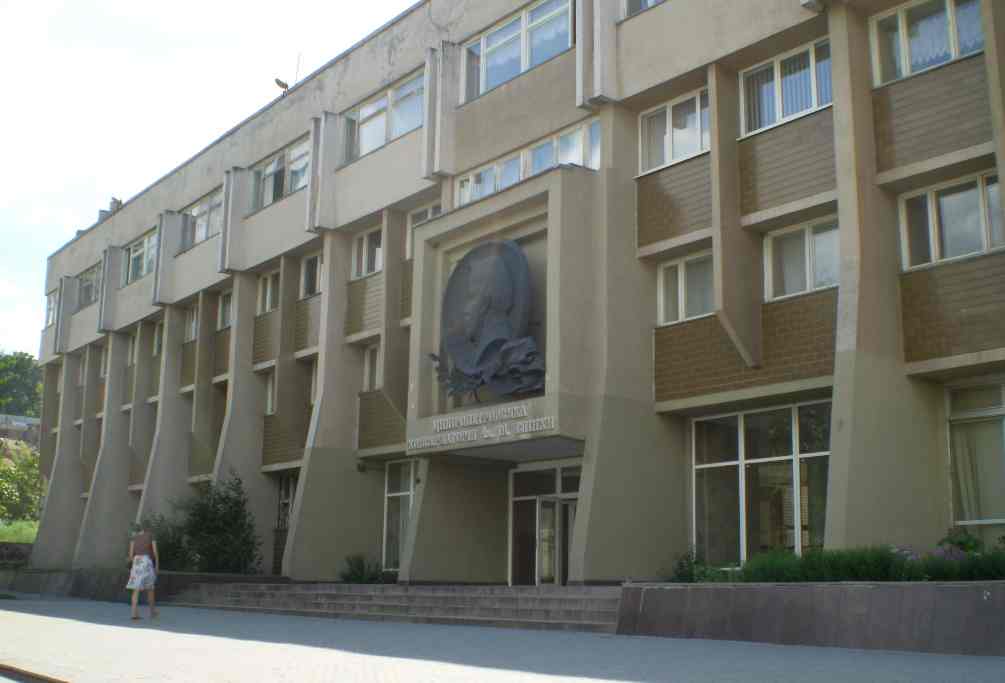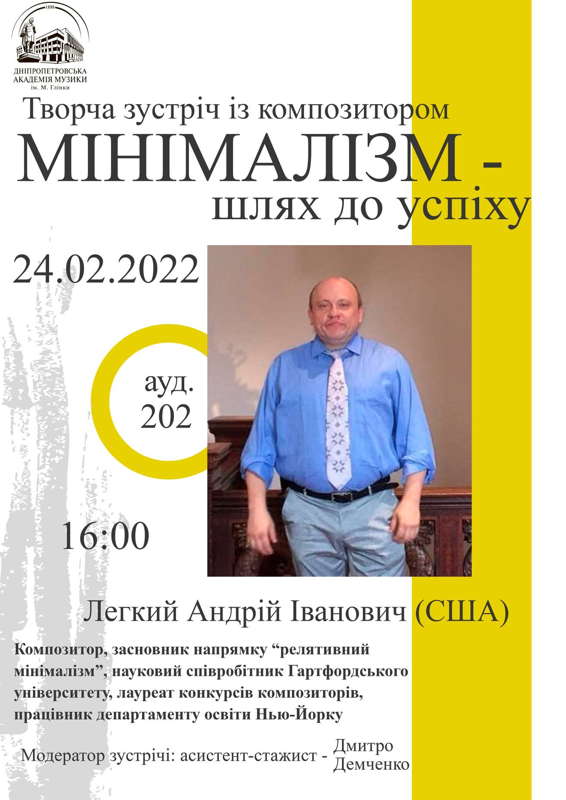ARTICLES BEING VIEWED NOW:
- Régine Crespin
- Hector Berlioz
- Ruth Railton
- Marián Varga
- Marina Koshetz
- Adrian Thompson
- Lenny Bernstein
- Mieczyslaw Weinberg
- Zahzah
- gypsies
- Bacewicz
- Benjamin Jaber
- Mišek: Sonata for Double Bass No 2
 DISCUSSION: John Dante Prevedini leads a discussion about Composers, individuals or collective?, including contributions from David Arditti, Halida Dinova, Robert McCarney and Jane Stanley.
DISCUSSION: John Dante Prevedini leads a discussion about Composers, individuals or collective?, including contributions from David Arditti, Halida Dinova, Robert McCarney and Jane Stanley.
Andriy Lehki

JOHN DANTE PREVEDINI interviews Ukrainian musicologist Andriy Lehki about his undelivered 24 February 2022 lecture, 'Minimalism - The Pathway to Success'
On 24 February 2022, the composer and musicologist Andriy Lehki was scheduled to deliver a lecture at the Dnipropetrovsk Conservatory in Ukraine titled Minimalism - The Pathway to Success. However, due to the outbreak of fighting in the country that same day, this culmination of his yearlong research had to be cancelled at the last minute. Here, Lehki joins us at Classical Music Daily to discuss the topic of his disrupted presentation: his highly original and insightful scholarship on the question of how contemporary minimalism has shaped the way today's audiences hear - and seek out - the repertoire of previous centuries.

Dnipropetrovsk Conservatory, Dnipro, Ukraine in 2007
Andriy Lehki (born 1968) is the founder and artistic director of the Ricercare Early Music Ensemble, the first professional ensemble of early music in Ukraine. He received his education in composition and music theory at the Lviv National Music Academy in Ukraine and the New School for Music at Mannes College in New York. In addition to his academic research, he is an active composer, teacher, conductor and organist/harpsichordist specializing in Baroque performance.

The lecture that didn't happen - the poster for Andriy Lehki's 24 February 2022 lecture, Minimalism - The Pathway to Success
John Dante Prevedini: Your research explores a new definition of the term 'minimalism' that can be applied to analysis of music from before the twentieth century. How is your definition of the term 'minimalism' here different from the way most theorists tend to use it?
Andriy Lehki: The term newly created by myself is 'relative minimalism', as it relates repertoire of different historical eras to present-day listening habits that have been shaped by contemporary minimalism. The idea of relative minimalism emerged as a result of the comparative characterization of historical musical works that are widely recognized and esteemed by general audiences around the world. The term 'relative' refers to my search for related sonic traits among pieces from different eras including the present. My research hypothesis is that the most popular pieces today from past eras are largely united by surface similarities in composition; specifically, I propose that most of them contain features that to general audiences might resemble contemporary minimalism.
JDP: You have advocated for minimalism (in the contemporary sense) as a pathway to 'success' for today's composers. What do you mean by 'success' here? Is this commercial success, frequent performances, popularity among listeners or some other measure?
AL: By successful music I mean music with a higher likelihood of recognition and listenership among the general public around the world.
JDP: What is the specific process you use for conducting this analysis on historic repertoire?
AL: To answer your question, it is necessary to first list the properties that tend to define 'minimalist' compositions in contemporary music. Today's composers who are considered as minimalist generally use a certain identifiable combination of techniques: ostinato, repetition, textural transformation, indeterminacy, simplicity, slow harmonic changes, metamorphosis, rhythmic transformation, melodic transformation, melodic cells, textural cells, resultant melody, tonal ambiguity, subtraction, addition, phasing and layering. The European branch of minimalism specifically adds more techniques, such as drones, tonality, modality, meditation references, tintinnabuli and early music references. Because this study focuses on the listening habits of today's general audiences, my approach emphasizes immediately audible surface structures rather than the historically contextualized analysis usually required by traditional musicology. I argue that many of the properties that have made contemporary minimalism so popular have also encouraged today's public to seek out compositions from previous centuries that have similar-sounding traits.
JDP: What do you hope this kind of analysis will ultimately reveal about the repertoire in question?
AL: If you replace traditional musicological analysis of this repertoire with analysis based on relative minimalism, you can use the results to predict the music's potential for widespread popular appeal today. My research so far indicates that the more 'relative minimalist' properties are audible to general audiences in a composition, the more that composition is likely to achieve widespread appeal, regardless of whether the music is old or new.
JDP: What are some examples of older pieces you have specifically analyzed in this way?
AL: Guillaume Dufay's Gloria ad modum tubae, Monteverdi's Zefiro Torna, his Toccata from L'Orfeo, Purcell's aria 'When I am Laid in Earth' from Dido and Aeneas, Pachelbel's Canon in D, numerous works by Vivaldi, J S Bach's 'Et Misericordia' from the Magnificat, his 'Herr, unser Herrscher, dessen Ruhm in allen Landen herrlich ist!' from the St John Passion, his Prelude in C Major from The Well-Tempered Clavier - Book 1, Händel's 'lascia ch'io pianga' from Rinaldo, Mozart's 'Lacrimosa' from the Requiem, Beethoven's first movement from the Sonata No 14 ('Moonlight') and Chopin's Preludes in E minor and B minor (Op 28, No 4 and No 6).
JDP: What do you believe is the relationship between this 'minimalism' of older eras and the 'minimalism' of contemporary composers like Glass, Reich, Pärt and others that most of us probably think of when we hear the term?
AL: For my concept of relative minimalism, the question of epoch makes no difference. We know that musical languages have undergone tremendous changes over the past thousand years; many new genres have been born, and many have disappeared. But my goal is to find out why some musical compositions from long ago are part of public knowledge today and others are not. And here, in my opinion, the answer lies in the hallmarks of relative minimalism that present-day listeners tend to hear within some historical repertoire. For instance, I compare the arpeggio figurations in Beethoven's Sonata No 14 with the arpeggio figurations that we can find in the music of Philip Glass. Both of these examples of arpeggios have a similar surface structure and likewise seem to satisfy a similar demand among today's listening public, even though they were composed in different centuries and would be analyzed very differently under traditional musicology.
JDP: How has minimalism, in either sense of the word, influenced the music you compose?
Listen — Andriy Lehki: Running for Flute, Alto Saxophone, Violin and Piano -
A sample from the February 2012 first performance
in the Concert Hall at Mannes College, New York, USA
given by Erica Chung, Scott Litroff, Halyna Lehki and Andriy lehki
AL: Minimalism, in the broadest sense of the word, gave me the key to understanding how my own music can speak directly to a wide range of listeners and still give me maximum freedom of musical expression.
Listen — Andriy Lehki: The Elegy of the Black Mountain
for violin solo and chamber orchestra -
Performance sample: Hartt Symphony Orchestra conducted by Edward Cumming
AL: My relative version of minimalism gives me the opportunity to explore how I can incorporate a range of techniques from throughout music history and still create something that sounds 'new' and accessible.
Copyright © 25 March 2022
John Dante Prevedini,
Connecticut, USA

CLASSICAL MUSIC ARTICLES ABOUT UKRAINE
FURTHER INTERVIEWS, PROFILES AND TRIBUTES


